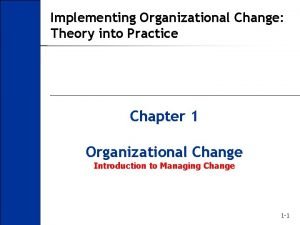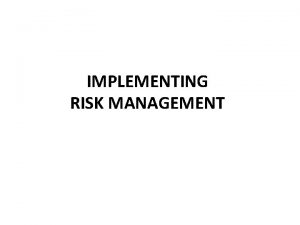Chapter 14 Implementing Strategic Change Strategic Management An













- Slides: 13

Chapter 14 Implementing Strategic Change Strategic Management An Integrated Approach Charles W. L. Hill Gareth R. Jones Power. Point Presentation by Charlie Cook Fifth Edition

Strategic Change Three major types of strategic change FIGURE 14. 1 Copyright © 2001 Houghton Mifflin Company. All rights reserved. 2

Stages in the Change Process FIGURE 14. 2 Copyright © 2001 Houghton Mifflin Company. All rights reserved. 3

Determining the Need for Change 1. Recognizing that a gap exists between desired and actual performance of the company. 2. Analyzing the organization’s current competitive position (SWOT analysis). 3. Determine the strategic changes necessary to achieve the desired future state for the company. Copyright © 2001 Houghton Mifflin Company. All rights reserved. 4

Determining the Obstacles to Change Corporate obstacles v Strategic changes alter core inner-workings of firm. Divisional obstacles v Interdivisional relationships are changed. Functional obstacles v Strategic change affects the orientation of functions. Individual obstacles v Individuals feel personally threatened by Copyright © 2001 Houghton Mifflin Company. All rights reserved. 5

Organizational Conflict: An Important Obstacle to Change Organizational conflict v The struggle between the conflicting goal-directed behaviors of different organizational groups. Stages in the Conflict Process FIGURE 14. 3 Copyright © 2001 Houghton Mifflin Company. All rights reserved. 6

Implementing Strategic Change and the Role of Organizational Politics Organizational politics v Tactics used by strategic managers to obtain and use power to influence organizational goals and further their own interests. Sources of organizational politics: v Disagreement over goals and means to attain them. v Lobbying for support in the decision-making process. v Personal reasons and ambitions of managers. Copyright © 2001 Houghton Mifflin Company. All rights reserved. 7

Rational and Political Views of Decision Making FIGURE 14. 4 Copyright © 2001 Houghton Mifflin Company. All rights reserved. 8

Effect of Organizational Politics on Performance FIGURE 14. 5 Copyright © 2001 Houghton Mifflin Company. All rights reserved. 9

Legitimate Power and Politics Power v The ability to cause something to be done that would not otherwise have been done. Legitimate power v The authority a manager possesses by virtue of holding a formal position in the hierarchy. Authority v The power to resolve conflicts and decide what needs to be done and overcome obstacles to change. Copyright © 2001 Houghton Mifflin Company. All rights reserved. 10

Informal Sources of Power FIGURE 14. 6 Copyright © 2001 Houghton Mifflin Company. All rights reserved. 11

Effects of Power and Politics on Strategic Change Controlling politics to promote change: v Devise organizational structure to create power-balancing arrangements between divisions. v Use corporate staff to influence strong divisions. v Have CEO come to the defense of less powerful divisions. v Reward risk taking and performance. Copyright © 2001 Houghton Mifflin Company. All rights reserved. 12

Managing and Evaluating Change Top-down change v Strong CEO takes charge of strategy process and moves quickly to implement changes. Bottom-up change v Top management consults with all levels of managers and, over time, develops a plan for change. v Disadvantage is that it is a slow process. v Advantage is that it overcomes obstacles to change through participation. Copyright © 2001 Houghton Mifflin Company. All rights reserved. 13
 Bert spector
Bert spector Implementing organizational change theory into practice
Implementing organizational change theory into practice Chapter 7 strategic management
Chapter 7 strategic management Strategy implementation example
Strategy implementation example Implementing strategies: management and operations issues
Implementing strategies: management and operations issues The pricing tripod
The pricing tripod Scoring model for project selection
Scoring model for project selection Strategic business unit structure
Strategic business unit structure Implementing strategies management and operations issues
Implementing strategies management and operations issues Technostructural interventions
Technostructural interventions Resource based model
Resource based model Analysing the 6 strategic options megxit
Analysing the 6 strategic options megxit Implementation of hrd program
Implementation of hrd program Implementing merchandise plans
Implementing merchandise plans

























